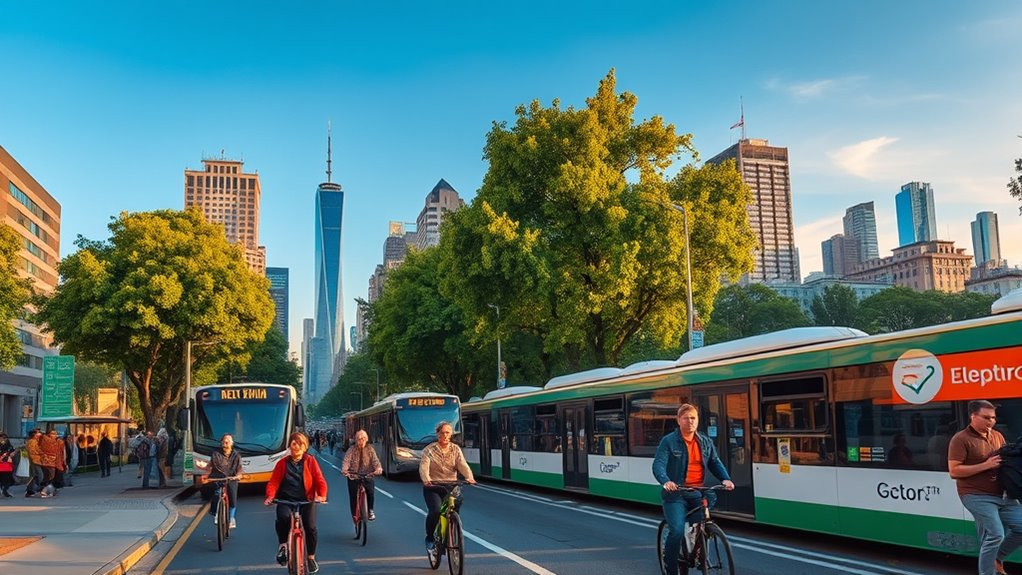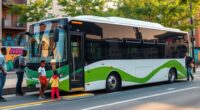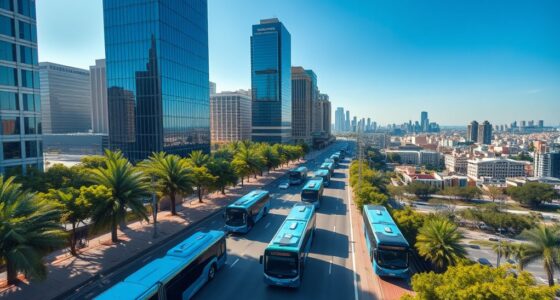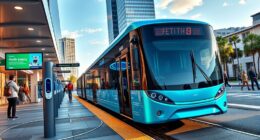Cleaner transit options, like electric vehicles and improved public transportation, have markedly improved urban air quality. As a result, cities see fewer respiratory illnesses such as asthma, bronchitis, and COPD, which means you’re less likely to experience breathing issues or need medical care. These public health gains show how policies and technology can make a real difference in your community’s health. Keep exploring to understand how these changes continue to protect your respiratory well-being.
Key Takeaways
- Cleaner transit options reduce vehicle emissions, lowering airborne pollutants linked to respiratory illnesses.
- Adoption of electric vehicles and improved public transportation decreases particulate matter exposure.
- Stricter emission regulations have led to better air quality, resulting in fewer asthma and COPD cases.
- Public health campaigns promote outdoor activity during low pollution periods, decreasing respiratory health risks.
- Overall improvements in air quality from cleaner transit contribute to lower rates of respiratory disease hospitalizations.

Have you ever wondered how far public health has come over the years? It’s incredible to see the progress made in improving air quality and, in turn, respiratory health. Decades ago, cities were choked with smog and pollution, making breathing difficult and increasing the prevalence of respiratory diseases like asthma, bronchitis, and COPD. Today, thanks to advancements in policies, technology, and public awareness, the air we breathe has become cleaner, leading to significant health benefits for communities everywhere.
The focus on reducing emissions from vehicles and industrial sources has played a vital role. Stricter regulations on pollutants such as particulate matter (PM), sulfur dioxide, and nitrogen oxides have led to a noticeable decline in air pollution levels. These efforts have been bolstered by the adoption of cleaner transportation options—electric vehicles, improved public transit systems, and cycling infrastructure—all of which cut down on harmful exhaust fumes. As a result, the air quality in many urban areas has improved substantially, directly impacting respiratory health. Fewer pollutants mean fewer irritants for our lungs, reducing the frequency and severity of respiratory episodes for vulnerable populations, including children, the elderly, and those with pre-existing conditions.
You might not realize how much these changes have lowered the rates of respiratory diseases. Studies consistently show that cleaner air correlates with fewer doctor visits, hospital admissions, and medication use related to respiratory issues. This isn’t just about fewer coughs and colds; it’s about real health outcomes. Better air quality means less inflammation and damage to lung tissue, helping individuals breathe more easily and recover faster from respiratory infections. It also reduces the incidence of chronic conditions that can severely impair quality of life, such as asthma attacks and COPD exacerbations.
Public health initiatives have also focused on awareness and early intervention. Educational campaigns emphasize the importance of air quality and encourage behaviors that protect respiratory health—like avoiding outdoor activity during high pollution days or using air purifiers indoors. These efforts empower individuals to take control of their health and reduce exposure to harmful pollutants. Furthermore, cities and governments continuously monitor air quality data, issuing alerts and implementing temporary measures to limit pollution peaks, further safeguarding respiratory health.
The cumulative effect of these improvements is evident. Communities are healthier, with fewer respiratory diseases and less strain on healthcare systems. It’s a demonstration of how concerted efforts—policy changes, technological advancements, and public engagement—can lead to cleaner air and a healthier population. You can appreciate the progress made, knowing that each step forward in reducing air pollution directly benefits your ability to breathe easier and stay healthier over the long term.
Frequently Asked Questions
How Do Cleaner Transit Options Impact Mental Health?
Cleaner transit options positively impact your mental health by improving air quality, which reduces exposure to pollutants that can cause stress and anxiety. As a result, you may experience less stress during your daily commute, leading to better mood and overall well-being. Additionally, knowing you’re contributing to a healthier environment can boost your sense of purpose and reduce mental fatigue, making your commute more calming and enjoyable.
What Are the Economic Benefits of Reduced Respiratory Diseases?
You save money on healthcare costs and boost your economic productivity when respiratory diseases decline. Fewer health issues mean less time off work and lower medical expenses, helping you and the economy thrive. Cleaner transit reduces the burden on healthcare systems and keeps you healthier, which translates into more consistent work performance. These benefits support economic growth and stability, making cleaner transportation options a smart investment for everyone.
How Quickly Can Communities See Health Improvements After Transit Changes?
You might see health improvements faster than you think—sometimes in just weeks! As soon as transit changes improve air quality, your community begins experiencing benefits. Reduced exposure to pollutants can quickly lower respiratory issues, making a noticeable difference in the health timeline. Keep in mind, the sooner cleaner transit is implemented, the sooner your community can breathe easier and enjoy healthier days ahead.
Are There Specific Populations That Benefit Most From Cleaner Transit?
You’ll find vulnerable populations benefit most from cleaner transit, as it helps mitigate health disparities they face. These communities often experience higher exposure to air pollution, so cleaner transit improves their respiratory health faster. By prioritizing access for vulnerable groups, you promote equity and ensure everyone gains from reduced respiratory diseases. This targeted approach maximizes health improvements and bridges gaps caused by environmental and social inequities.
What Challenges Exist in Implementing Cleaner Transit Solutions Nationwide?
Implementing cleaner transit solutions nationwide is like trying to steer a massive ship through a storm—funding hurdles and policy barriers threaten to sink progress. You face challenges in securing consistent funding, as budgets fluctuate, and maneuvering complex regulations that slow adoption. Overcoming these obstacles requires coordinated efforts, innovative financing, and policy reforms to smooth the journey toward cleaner, healthier transit options for everyone.
Conclusion
You might think cleaner transit only benefits the environment, but it also genuinely reduces respiratory diseases. By investing in cleaner transportation, you’re helping protect your community’s health and well-being. This shows how small changes can lead to big health improvements, proving that environmental efforts and public health are truly interconnected. So, next time you choose greener options, remember—you’re not just helping the planet, but also safeguarding your own health.









